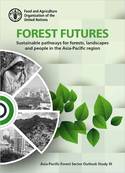Asia-Pacific Forest Sector Outlook Study
The demand of society on forests has continuously changed. Initially, forests were mainly seen as resources for timber. Overtime, the role of forests has expanded as our society expects various economic, social and environmental products and services from the forests. Forests now are seen as a component of broader landscapes. The interconnectedness of forests to other sectors has become much more understood. Also, there is a better appreciation of the environmental and cultural role of forests. Looking into the future, it is very important for governments, organizations, private sector and other stakeholders to understand the roles of forests and forestry in the next decades. This will help them in designing their interventions, investments and strategic planning.
In the past, in collaboration with governments and partners, FAO has undertaken regional and global outlook studies to assess how the future is likely to unfold and to identify challenges and opportunities that are likely to emerge. FAO completed the first Asia-Pacific Forestry Sector Outlook Study (APFSOS I) in 1998 and APFSOS II in 2010. Governments appreciated the results of the studies as they used them for strategic planning at national and sub-national levels. Policy dialogues involving key stakeholders such as private sector, international organizations, donors, youth, etc. on issues such as investment, partnership and priorities in the forestry sector were also informed by the results of these studies. Additionally, various organizations have used the studies for research and capacity building.
While the broad trends outlined in APFSOS II are still valid, there is a need to discuss and provide an overview of the probable paths of forestry development to the year 2030 and beyond. APFSOS III will consider the implications of new international frameworks and agreements, new technologies, the role of youth in the future, the changing pace of globalization, the importance of environmental services and conservation, etc. All of these factors could possibly take forestry along a trajectory different from what was visualized earlier.
The third Asia-Pacific Forest Sector Outlook Study (APFSOS III) was launched June 18, 2019 at the Asia-Pacific Forest Week 2019 (APFW 2019) to be held from 17-21 June in Incheon, Republic of Korea.
This brochure describes how APFSOS III will help to provide a clear picture of emerging opportunities and challenges for forestry in Asia and the Pacific to 2030 and beyond, laying out a solid foundation for long-term strategic planning by decision-makers including governments, investors, industries, international organizations and civil society organizations.
Second edition
This publication summarizes the key findings and results of the second Asia-Pacific Forestry Sector Outlook Study - a comprehensive effort spanning nearly four years and involving all member countries of the Asia-Pacific Forestry Commission. The current report synthesizes observations and findings from almost 50 country and thematic reports in providing analyses of the status and trends of all aspects of Asia-Pacific Forestry. The publication also analyzes key factors driving changes in forestry in the region and sets out three scenarios for 2020: "Boom", "Bust" and "Green Economy". The report concludes by outlining priorities and strategies to move the region's forestry sector onto a more sustainable footing and to provide continued benefits to future generations.
This subregional report summarizes the key findings and results from eight country reports, numerous thematic reports and a wide ranging review of current and past publications in providing analyses of the status and trends of forests and forestry in Southeast Asia. The publication also analyses key factors driving changes in forestry and outlines priorities and strategies for the subregion’s forestry sector.
The subregional report for South Asia provides an assessment of developments in the South Asian forestry sector, linking it with larger societal changes. It gives an overview of the forestry sector, including the economic, social and ecological significance of forests and summarizes major developments, including changes in demand for forest products and ecosystem services - specifically highlighting resource constraints in the subregion. The report analyses the key factors driving developments in the forest sector, scenarios that may unfold, and how forests and forestry are likely to evolve to the year 2020. The report also outlines priorities and strategies to enhance forestry's contribution to societal well-being.
The subregional report for East Asia summarizes the key findings and results from four country reports, in providing analyses of the status and trends of forests and forestry in East Asia encompassing the largest forestry economies in Asia and the Pacific. The publication also analyses key factors driving changes in forestry in the subregion and outlines priorities and strategies for the subregion’s forestry sector.
The subregional report for the Pacific provides an invaluable compendium of information and analysis on the current forestry situation in the Pacific subregion and likely future developments. Key drivers of change in forestry are identified and their future impacts assessed; potential future scenarios are also developed. The report culminates in a description of the likely situation in 2020 and identification of priorities and strategies to steer the sector towards more favourable outcomes.








